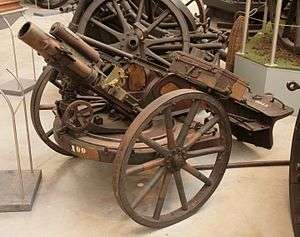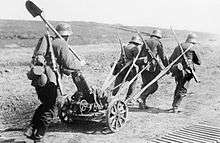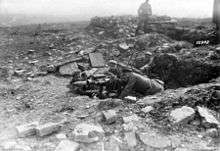7.58 cm Minenwerfer
The 7.58 cm Minenwerfer a.A. (alter Art or old model) (7.58 cm leMW), was a German First World War mortar.
| 7.58 cm Minenwerfer a.A. | |
|---|---|
 A 7.58 cm Minenwerfer at the Brussels Army Museum | |
| Type | Light mortar |
| Place of origin | German Empire |
| Service history | |
| Used by | German Empire |
| Wars | World War I |
| Production history | |
| Designer | Rheinmetall |
| Designed | 1909 |
| Manufacturer | Rheinmetall |
| Variants | n.A. |
| Specifications | |
| Mass | 147 kg (324 lbs) |
| Barrel length | 23.5 cm (9.3 in) L/3.1 |
| Crew | 5-6 |
| Shell | 4.6 kg (10 lb 2 oz) |
| Caliber | 75.8 mm (2.99 in) |
| Recoil | hydro-spring |
| Carriage | platform |
| Elevation | + 45 to + 78 degrees |
| Traverse | 7° |
| Rate of fire | 6 rounds per minute |
| Muzzle velocity | 90 m/s (259 ft/s) |
| Effective firing range | 300 m (328 yds) minimum |
| Maximum firing range | 1,300 m (1,421 yds) |
History


The Russo-Japanese War of 1905 had shown the value of mortars against modern fieldworks and fortifications and the Germans were in the process of fielding a whole series of mortars before the beginning of World War I. Their term for them was Minenwerfer, literally mine-thrower; they were initially assigned to engineer units in their siege warfare role. By the Winter of 1916-17, they were transferred to infantry units where the leMW's light weight permitted them to accompany the foot-soldiers in the advance.
In common with Rheinmetall's other Minenwerfer designs, the leMW was a rifled muzzle-loader that had hydraulic cylinders on each side of the tube to absorb the recoil forces and spring recuperators to return the tube to the firing position. It had a rectangular firing platform with limited traverse and elevation. Wheels could be added to ease transportation or it could be carried by at least six men. In 1916, a new model, designated as the n.A. or neuer Art (new version), was fielded that included a circular firing platform, giving a turntable effect, which permitted a full 360 degree traverse. It also had a longer 16 inches (410 mm) barrel and could be used for direct fire between 0° and 27° elevation if the new 90 kg (200 lb) trail was fitted to absorb the recoil forces. In this mode it was pressed into service as an anti-tank gun.
See also
Weapons of comparable role, performance and era
- Stokes mortar : approximate British equivalent
References
- Jäger, Herbert. German Artillery of World War One. Ramsbury, Marlborough, Wiltshire: Crowood Press, 2001 ISBN 1-86126-403-8
External links
| Wikimedia Commons has media related to 7.58 cm Minenwerfer. |